Dental Pulp Stem Cell-Derived Organoids: Advancing the Development of 3D Structures
Abstract
Highlights
- The main aim of this article is to propose a validated and standardized protocol for characterising and conducting advanced structural analyses of dental pulp-like organoids using Raman microspectroscopy.
- These findings demonstrate improved reproducibility and reliability of these models and could have significant implications for their use in preclinical studies and drug screening.
- Furthermore, enabling Raman microspectroscopy to investigate the structural organisation of 3D dental pulp organoids paves the way for future clinical applications in the critical fields of bone tissue engineering and regenerative medicine.
Abstract
1. Introduction
2. Materials and Methods
2.1. Primary Cell Lines and Cultures
2.2. Development of Organoids from Dental Pulp Stem Cells
2.3. Osteogenic Differentiation of Organoids
2.4. Organoids Viability Evaluation
2.5. Organoids Morphological Evaluation by Stereo Microscope
2.6. Preparation of Frozen Sections and Hematoxylin and Eosin Staining
2.7. Alizarin Red Staining
2.8. Immunofluorescence Analysis
- CD105, monoclonal, mouse (Santa Cruz Biotechnology, Dallas, TX, USA), dilution 1:50
- OSX monoclonal, mouse (Santa Cruz Biotechnology, Dallas, TX, USA), dilution 1:50.
- RUNX2, monoclonal rabbit (Cell Signaling Technology Inc., Danvers, MA, USA), dilution 1:250.
- FITC-Phalloidin mouse (Merk Life Science, Sigma Aldrich, Milan, Italy), dilution 1:1000.
2.9. Raman Microspectroscopy (RMS)
2.10. Statistical Analysis
3. Results
3.1. Establishment of 3D Organoids Cultures
3.2. Organoids Vitality
3.3. Morphological Features of Dental Pulp Organoids
3.4. Calcium Carbonate Deposition in Dental Pulp Organoids
3.5. Characterisation of Chemical Structure and Crystallinity by RMS
3.6. Immunofluorescence Analysis of DPSCs Organoids
4. Discussion
Author Contributions
Funding
Institutional Review Board Statement
Informed Consent Statement
Data Availability Statement
Acknowledgments
Conflicts of Interest
Abbreviations
| 2D models | Bi-dimensional Models |
| 3D models | Three-dimensional Models |
| ASCs | Adult Stem Cells |
| BSA | Bovine Serum Albumin |
| CCD detector | Charge-Coupled Device Detector |
| CCK8 | Cell Counting Kit-8 Assay |
| CD105 | Endoglin |
| DAPI | 4′,6-Diamidino-2-Phenylindole |
| DMEM-LG | Dulbecco’s Modified Eagle’s Medium with Low Glucose |
| DMSO | Dimethyl Sulfoxide |
| DPSCs | Dental Pulp Stem Cells |
| EC | Endothelial cells |
| EDTA | Ethylenediaminetetraacetic Acid |
| FBS | Fetal Bovine Serum |
| FITC | Fluorescein Isothiocyanate |
| FWHM | Full Width at Half Maximum |
| HA | Hydroxyapatite |
| hDP-ECM | Human Dental Pulp derived ExtraCellular Matrix |
| MSCs | Mesenchymal Stem/Stromal Cells |
| OCT | Optimal Cutting Temperature |
| ODM | Osteogenic Differentiation Medium |
| OSX | Osterix |
| PBS | Phosphate-Buffered Saline |
| PFA | Paraformaldehyde |
| RMS | Raman microspectroscopy |
| RT | Room Temperature |
| RT-qPCR | Reverse Transcription quantitative Polymerase Chain Reaction |
| RUNX2 | Runt-related Transcription Factor 2 |
| SD | Standard Deviation |
References
- Clevers, H. Modeling Development and Disease with Organoids. Cell 2016, 165, 1586–1597. [Google Scholar] [CrossRef]
- Dutta, D.; Heo, I.; Clevers, H. Disease Modeling in Stem Cell-Derived 3D Organoid Systems. Trends Mol. Med. 2017, 23, 393–410. [Google Scholar] [CrossRef]
- Lancaster, M.A.; Knoblich, J.A. Organogenesis in a dish: Modeling development and disease using organoid technologies. Science 2014, 345, 1247125. [Google Scholar] [CrossRef] [PubMed]
- Vazquez-Armendariz, A.I.; Tata, P.R. Recent advances in lung organoid development and applications in disease modeling. J. Clin. Investig. 2023, 133, e170500. [Google Scholar] [CrossRef]
- Marconi, G.D.; Mazzone, A.; Della Rocca, Y.; Trubiani, O.; Pizzicannella, J.; Diomede, F. Three-Dimensional Culture System: A New Frontier in Cancer Research, Drug Discovery, and Stem Cell-Based Therapy. Biology 2025, 14, 875. [Google Scholar] [CrossRef]
- Broutier, L.; Mastrogiovanni, G.; Verstegen, M.M.; Francies, H.E.; Gavarro, L.M.; Bradshaw, C.R.; Allen, G.E.; Arnes-Benito, R.; Sidorova, O.; Gaspersz, M.P.; et al. Human primary liver cancer-derived organoid cultures for disease modeling and drug screening. Nat. Med. 2017, 23, 1424–1435. [Google Scholar] [CrossRef]
- Mann, M.B.; Jenkins, N.A.; Copeland, N.G.; Mann, K.M. Sleeping Beauty mutagenesis: Exploiting forward genetic screens for cancer gene discovery. Curr. Opin. Genet. Dev. 2014, 24, 16–22. [Google Scholar] [CrossRef]
- Drost, J.; Clevers, H. Organoids in cancer research. Nat. Rev. Cancer 2018, 18, 407–418. [Google Scholar] [CrossRef]
- Tiwari, S.K.; Wong, W.J.; Moreira, M.; Pasqualini, C.; Ginhoux, F. Induced pluripotent stem cell-derived macrophages as a platform for modelling human disease. Nat. Rev. Immunol. 2025, 25, 108–124. [Google Scholar] [CrossRef] [PubMed]
- Roy, N.S.; Kumari, M.; Alam, K.; Bhattacharya, A.; Kaity, S.; Kaur, K.; Ravichandiran, V.; Roy, S. Development of bioengineered 3D patient derived breast cancer organoid model focusing dynamic fibroblast-stem cell reciprocity. Prog. Biomed. Eng. 2024, 7, 012007. [Google Scholar] [CrossRef] [PubMed]
- Jones, M.K.; Orozco, L.D.; Qin, H.; Truong, T.; Caplazi, P.; Elstrott, J.; Modrusan, Z.; Chaney, S.Y.; Jeanne, M. Integration of human stem cell-derived in vitro systems and mouse preclinical models identifies complex pathophysiologic mechanisms in retinal dystrophy. Front. Cell Dev. Biol. 2023, 11, 1252547. [Google Scholar] [CrossRef]
- Delle Monache, S.; Pulcini, F.; Santilli, F.; Martellucci, S.; Santacroce, C.; Fabrizi, J.; Angelucci, A.; Sorice, M.; Mattei, V. Hypoxia Induces DPSC Differentiation versus a Neurogenic Phenotype by the Paracrine Mechanism. Biomedicines 2022, 10, 1056. [Google Scholar] [CrossRef] [PubMed]
- Advani, D.; Barragan, J.V.; Statache, G.; Kadri, N.; Kohli, N. Upcycled Mesenchymal Stem Cells: Repurposing Biological Waste Towards Sustainable Regenerative Therapies. Cell Ther. Eng. Connect. 2025, 1, 0003. [Google Scholar] [CrossRef]
- Gronthos, S.; Mankani, M.; Brahim, J.; Robey, P.G.; Shi, S. Postnatal human dental pulp stem cells (DPSCs) in vitro and in vivo. Proc. Natl. Acad. Sci. USA 2000, 97, 13625–13630. [Google Scholar] [CrossRef] [PubMed]
- Stefanska, K.; Volponi, A.A.; Kulus, M.; Wasko, J.; Farzaneh, M.; Grzelak, J.; Azizidoost, S.; Mozdziak, P.; Bukowska, D.; Antosik, P.; et al. Dental pulp stem cells—A basic research and future application in regenerative medicine. Biomed. Pharmacother. 2024, 178, 116990. [Google Scholar] [CrossRef]
- Yang, S.; Hu, H.; Kung, H.; Zou, R.; Dai, Y.; Hu, Y.; Wang, T.; Lv, T.; Yu, J.; Li, F. Organoids: The current status and biomedical applications. MedComm (2020) 2023, 4, e274. [Google Scholar] [CrossRef]
- Shao, Y.; Wang, J.; Jin, A.; Jiang, S.; Lei, L.; Liu, L. Biomaterial-assisted organoid technology for disease modeling and drug screening. Mater. Today Bio 2025, 30, 101438. [Google Scholar] [CrossRef]
- He, J.; Zhang, X.; Xia, X.; Han, M.; Li, F.; Li, C.; Li, Y.; Gao, D. Organoid technology for tissue engineering. J. Mol. Cell Biol. 2020, 12, 569–579. [Google Scholar] [CrossRef]
- Jeong, S.Y.; Lee, S.; Choi, W.H.; Jee, J.H.; Kim, H.R.; Yoo, J. Fabrication of Dentin-Pulp-Like Organoids Using Dental-Pulp Stem Cells. Cells 2020, 9, 642. [Google Scholar] [CrossRef]
- Lancia, L.; Mauro, A.; Mattei, V.; Delle Monache, S.; Pulcini, F. Protocol for the Generation and Analysis of Organoids from Dental Pulp Stem Cells (DPSCs). Tissue Cell 2025, 96, 103010. [Google Scholar] [CrossRef]
- Ohlsson, E.; Galler, K.M.; Widbiller, M. A Compilation of Study Models for Dental Pulp Regeneration. Int. J. Mol. Sci. 2022, 23, 14361. [Google Scholar] [CrossRef]
- Wu, Y.; Li, X.; Liu, H.; Yang, X.; Li, R.; Zhao, H.; Shang, Z. Author correction: Organoids in the oral and maxillofacial region: Present and future. Int. J. Oral Sci. 2025, 17, 43. [Google Scholar] [CrossRef]
- Hermans, F.; Hemeryck, L.; Bueds, C.; Torres Pereiro, M.; Hasevoets, S.; Kobayashi, H.; Lambrechts, D.; Lambrichts, I.; Bronckaers, A.; Vankelecom, H. Organoids from mouse molar and incisor as new tools to study tooth-specific biology and development. Stem Cell Rep. 2023, 18, 1166–1181. [Google Scholar] [CrossRef]
- Xu, X.; Li, Z.; Ai, X.; Tang, Y.; Yang, D.; Dou, L. Human three-dimensional dental pulp organoid model for toxicity screening of dental materials on dental pulp cells and tissue. Int. Endod. J. 2022, 55, 79–88. [Google Scholar] [CrossRef]
- Orilisi, G.; Monterubbianesi, R.; Notarstefano, V.; Tosco, V.; Vitiello, F.; Giuliani, G.; Putignano, A.; Orsini, G. New insights from Raman MicroSpectroscopy and Scanning Electron Microscopy on the microstructure and chemical composition of vestibular and lingual surfaces in permanent and deciduous human teeth. Spectrochim. Acta A Mol. Biomol. Spectrosc. 2021, 260, 119966. [Google Scholar] [CrossRef]
- Notarstefano, V.; Belloni, A.; Mariani, P.; Orilisi, G.; Orsini, G.; Giorgini, E.; Byrne, H.J. Multivariate curve Resolution-Alternating least squares coupled with Raman microspectroscopy: New insights into the kinetic response of primary oral squamous carcinoma cells to cisplatin. Analyst 2023, 148, 4365–4372. [Google Scholar] [CrossRef] [PubMed]
- Butler, H.J.; Ashton, L.; Bird, B.; Cinque, G.; Curtis, K.; Dorney, J.; Esmonde-White, K.; Fullwood, N.J.; Gardner, B.; Martin-Hirsch, P.L.; et al. Using Raman spectroscopy to characterize biological materials. Nat. Protoc. 2016, 11, 664–687. [Google Scholar] [CrossRef] [PubMed]
- Dominici, M.; Le Blanc, K.; Mueller, I.; Slaper-Cortenbach, I.; Marini, F.; Krause, D.; Deans, R.; Keating, A.; Prockop, D.; Horwitz, E. Minimal criteria for defining multipotent mesenchymal stromal cells. The International Society for Cellular Therapy position statement. Cytotherapy 2006, 8, 315–317. [Google Scholar] [CrossRef] [PubMed]
- Mattei V, Santilli F, Pulcini F, Fabrizi J, Lancia L, Santacroce C, Megiorni F, Ceccarelli S, Paldino E, Gramignoli R, Roubelakis MG, Bahareh S, Vosough M, Bollini S, Galderisi U, Salgado AJ, Angeloni A, Marchese C, Delle Monache S. Validated methods for isolation and qualification of mesenchymal stromal/stem cells from different sources. J. Transl. Med. 2025, 23, 975. [Google Scholar] [CrossRef]
- Li, Y.; Zhang, Y.; Zhang, G. Comparative Analysis of Decellularization Methods for the Production of Decellularized Um-bilical Cord Matrix. Curr. Issues Mol. Biol. 2024, 46, 7686–7701. [Google Scholar] [CrossRef]
- Yin, X.; Mead, B.E.; Safaee, H.; Langer, R.; Karp, J.M.; Levy, O. Engineering Stem Cell Organoids. Cell Stem Cell 2016, 18, 25–38. [Google Scholar] [CrossRef]
- Ramakrishnaiah, R.; Rehman Gur Basavarajappa, S.; Al Khuraif, A.A.; Durgesh, B.H.; Khan, A.S.; Rehman, I.u. Applications of Raman Spectroscopy in Dentistry: Analysis of Tooth Structure. Appl. Spectrosc. Rev. 2015, 50, 332–350. [Google Scholar] [CrossRef]
- Torres, C.P.; Miranda Gomes-Silva, J.; Menezes-Oliveira, M.A.H.; Silva Soares, L.E.; Palma-Dibb, R.G.; Borsatto, M.C. FT-Raman spectroscopy, micro-EDXRF spectrometry, and microhardness analysis of the dentin of primary and permanent teeth. Microsc. Res. Tech. 2018, 81, 509–514. [Google Scholar] [CrossRef]
- Notarstefano, V.; Pisani, M.; Bramucci, M.; Quassinti, L.; Maggi, F.; Vaccari, L.; Parlapiano, M.; Giorgini, E.; Astolfi, P. A vibrational in vitro approach to evaluate the potential of monoolein nanoparticles as isofuranodiene carrier in MDA-MB 231 breast cancer cell line: New insights from Infrared and Raman microspectroscopies. Spectrochim. Acta A Mol. Biomol. Spectrosc. 2022, 269, 120735. [Google Scholar] [CrossRef]
- Anwar Alebrahim, M.K.C.; Sekhaneh, W.; Sigusch, B.; Popp, J. ATR-FTIR and Raman spectroscopy of primary and permanent teeth. Biomed. Spectrosc. Imaging 2014, 3, 15–27. [Google Scholar] [CrossRef]
- Tubbesing, K.; Moskwa, N.; Khoo, T.C.; Nelson, D.A.; Sharikova, A.; Feng, Y.; Larsen, M.; Khmaladze, A. Raman microspectroscopy fingerprinting of organoid differentiation state. Cell. Mol. Biol. Lett. 2022, 27, 53. [Google Scholar] [CrossRef] [PubMed]
- Enrich-Essvein, T.; Benavides-Reyes, C.; Alvarez-Lloret, P.; Bolanos-Carmona, M.V.; Rodriguez-Navarro, A.B.; Gonzalez-Lopez, S. Influence of de-remineralization process on chemical, microstructural, and mechanical properties of human and bovine dentin. Clin. Oral Investig. 2021, 25, 841–849. [Google Scholar] [CrossRef] [PubMed]
- d’Aquino, R.; Graziano, A.; Sampaolesi, M.; Laino, G.; Pirozzi, G.; De Rosa, A.; Papaccio, G. Human postnatal dental pulp cells co-differentiate into osteoblasts and endotheliocytes: A pivotal synergy leading to adult bone tissue formation. Cell Death Differ. 2007, 14, 1162–1171. [Google Scholar] [CrossRef]
- La Noce, M.; Paino, F.; Spina, A.; Naddeo, P.; Montella, R.; Desiderio, V.; De Rosa, A.; Papaccio, G.; Tirino, V.; Laino, L. Dental pulp stem cells: State of the art and suggestions for a true translation of research into therapy. J. Dent. 2014, 42, 761–768. [Google Scholar] [CrossRef]
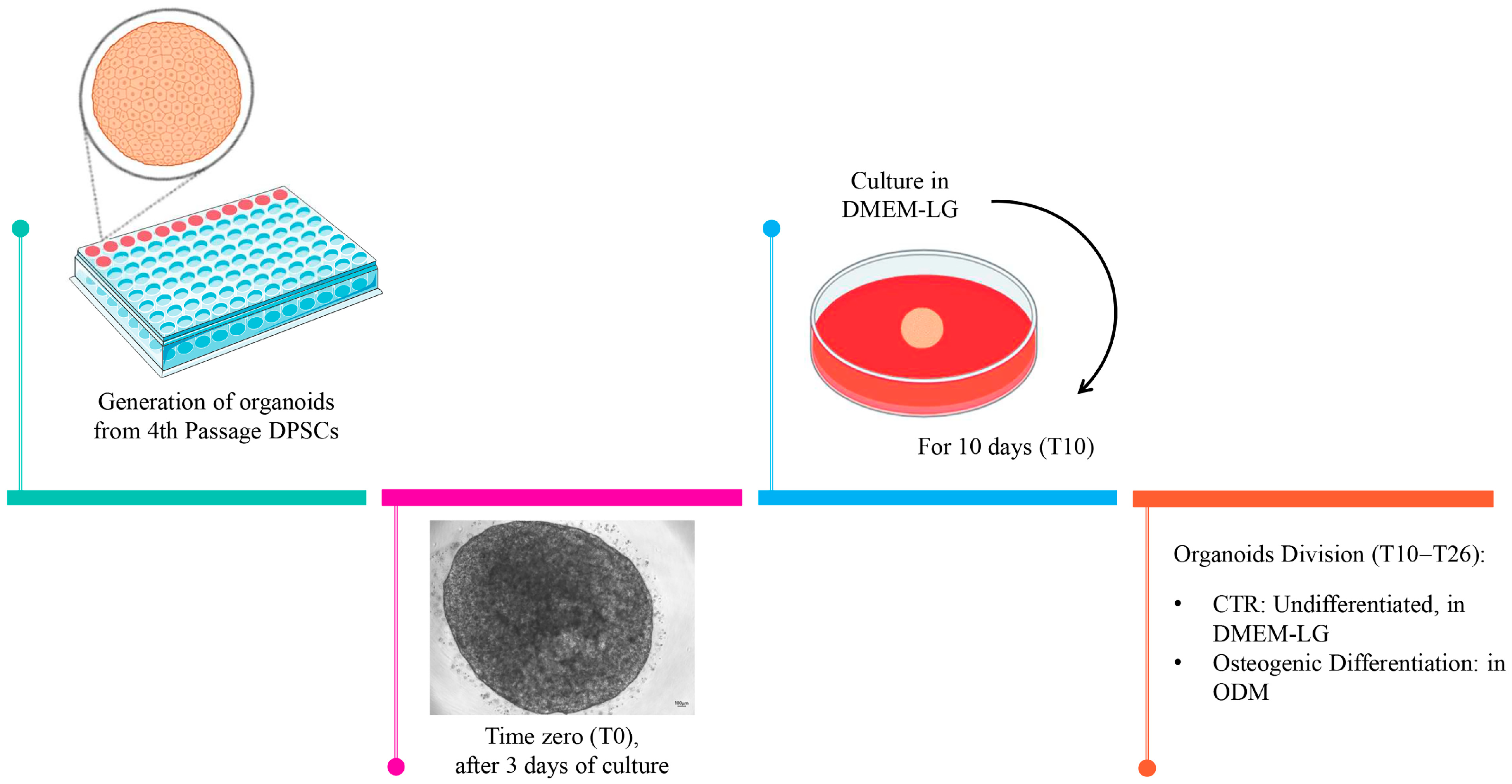

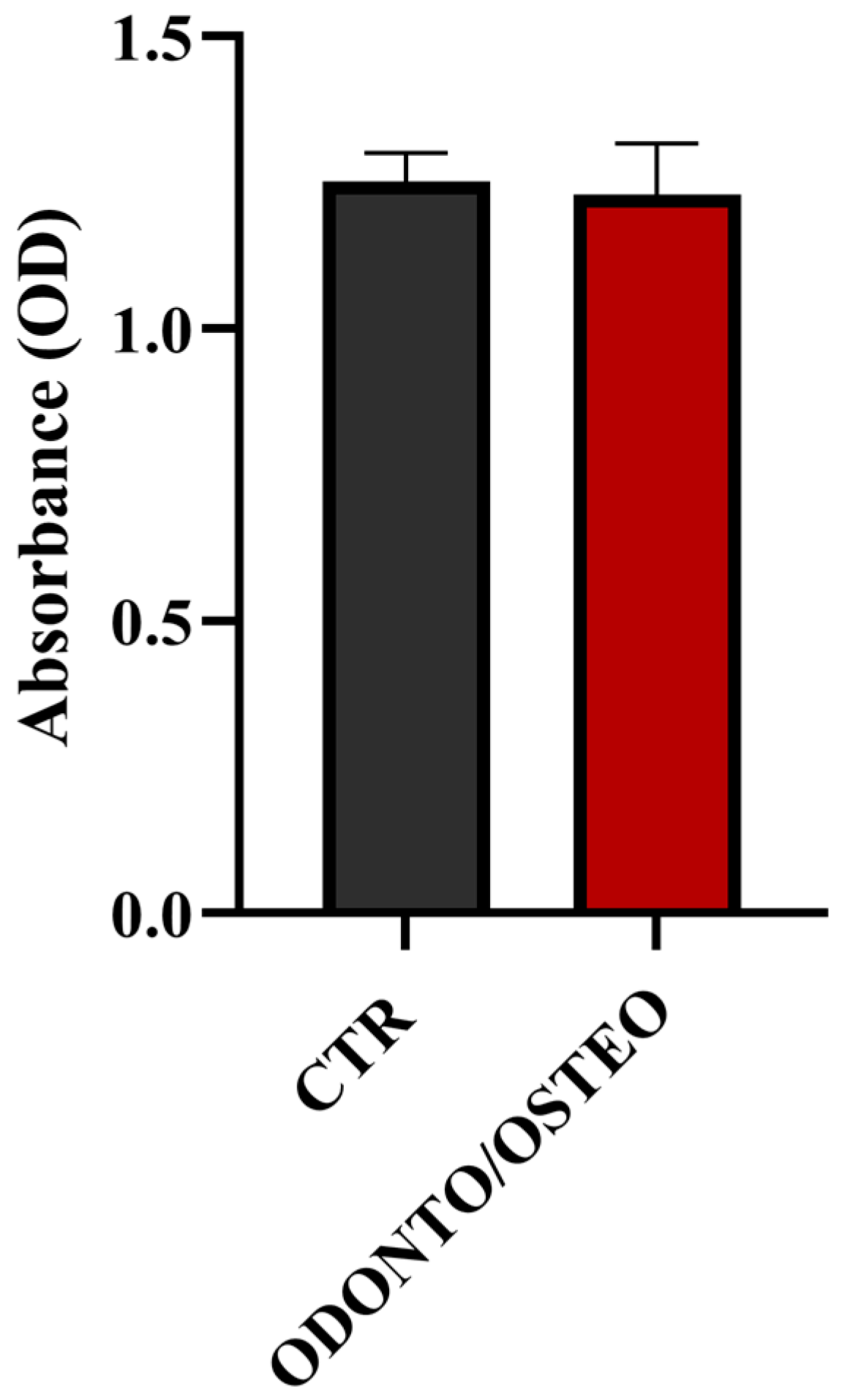
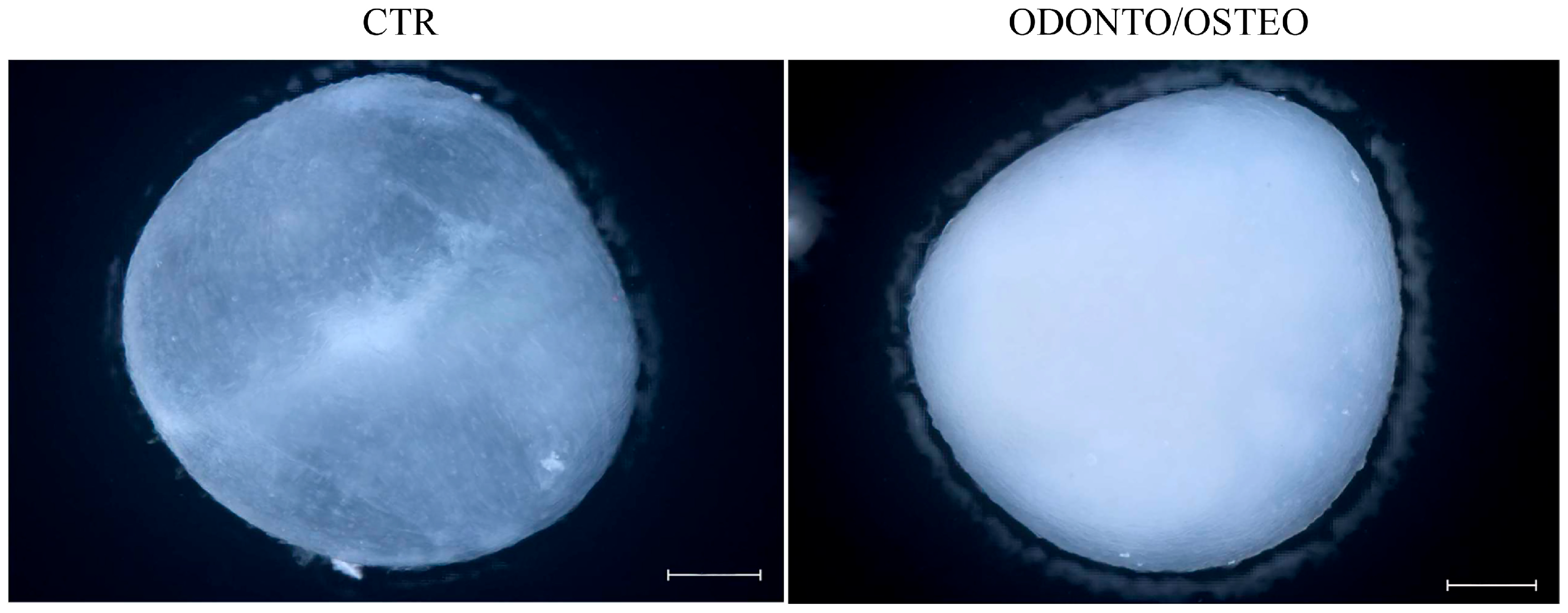
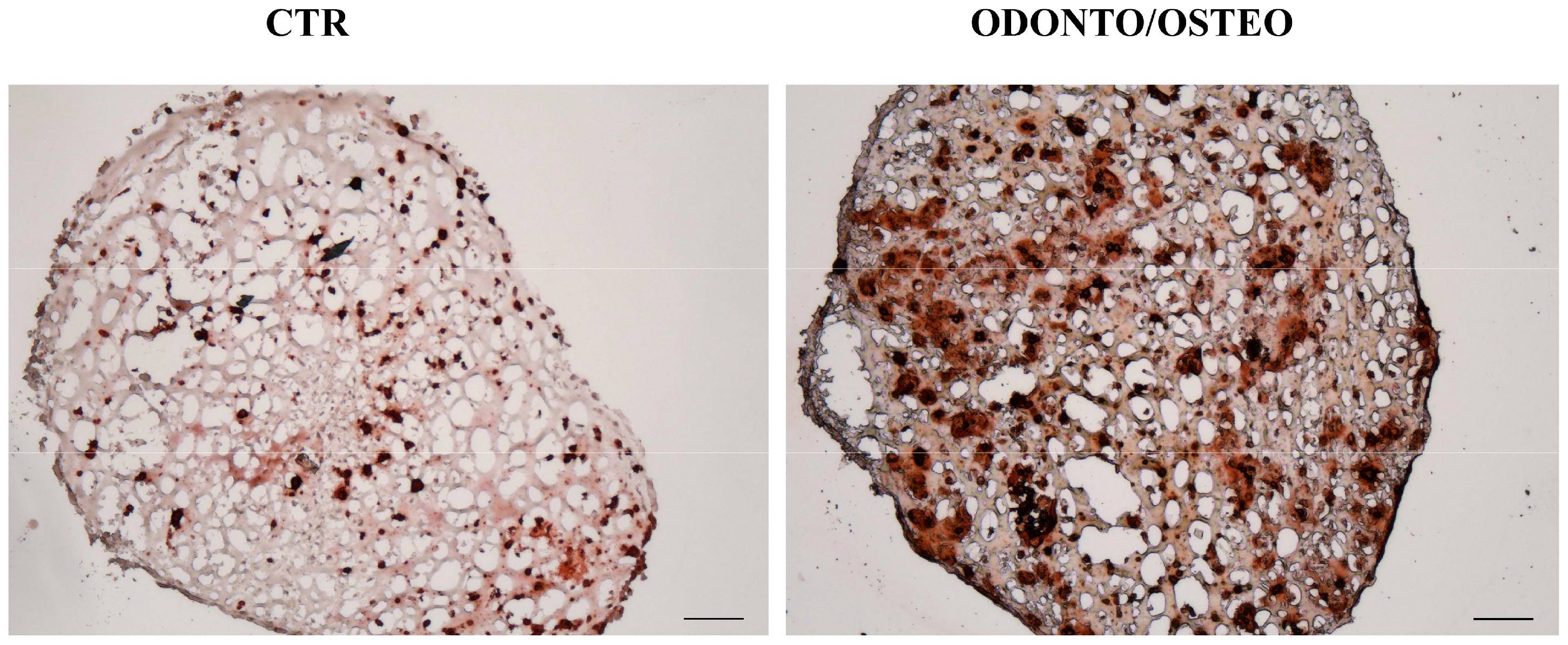
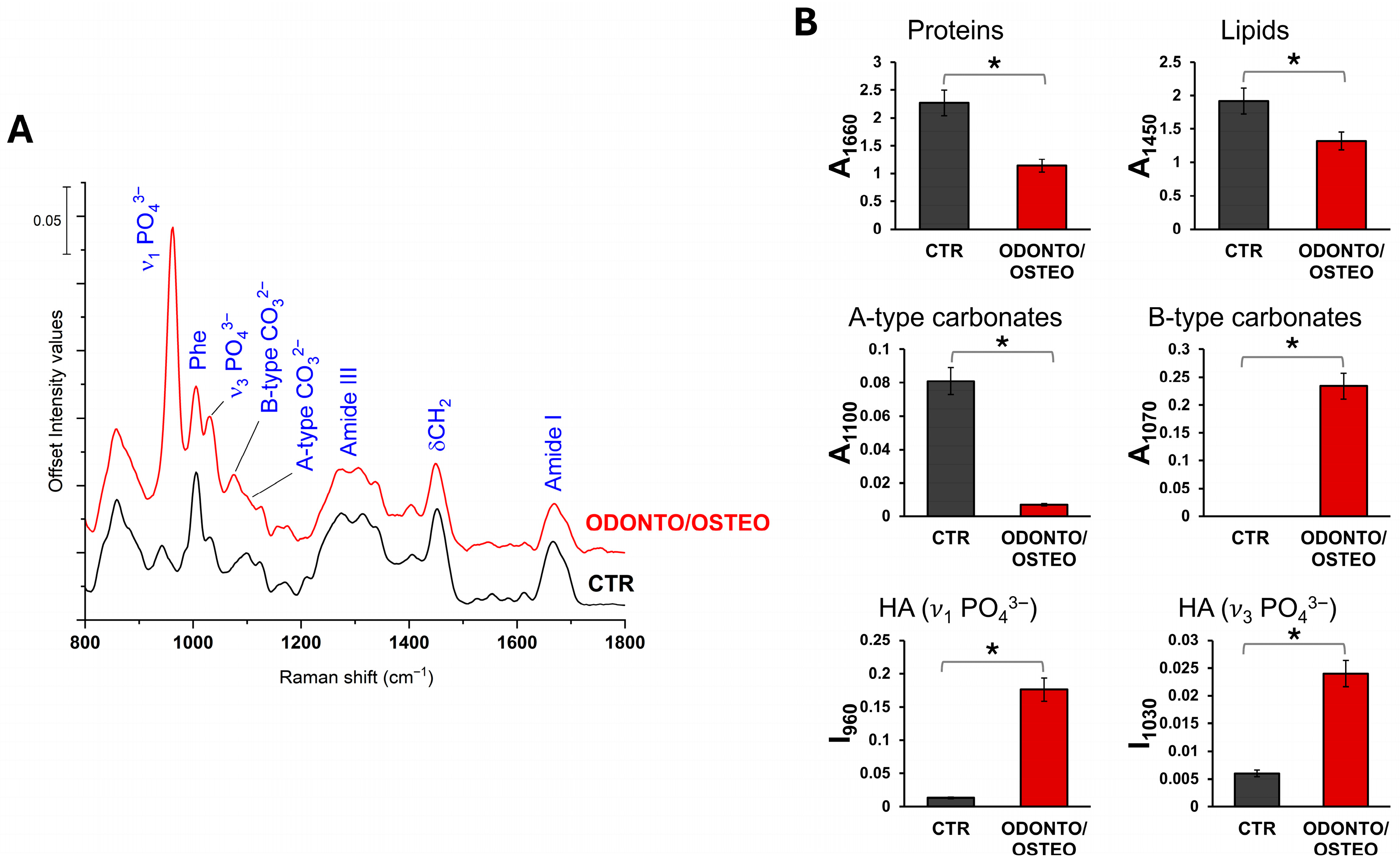

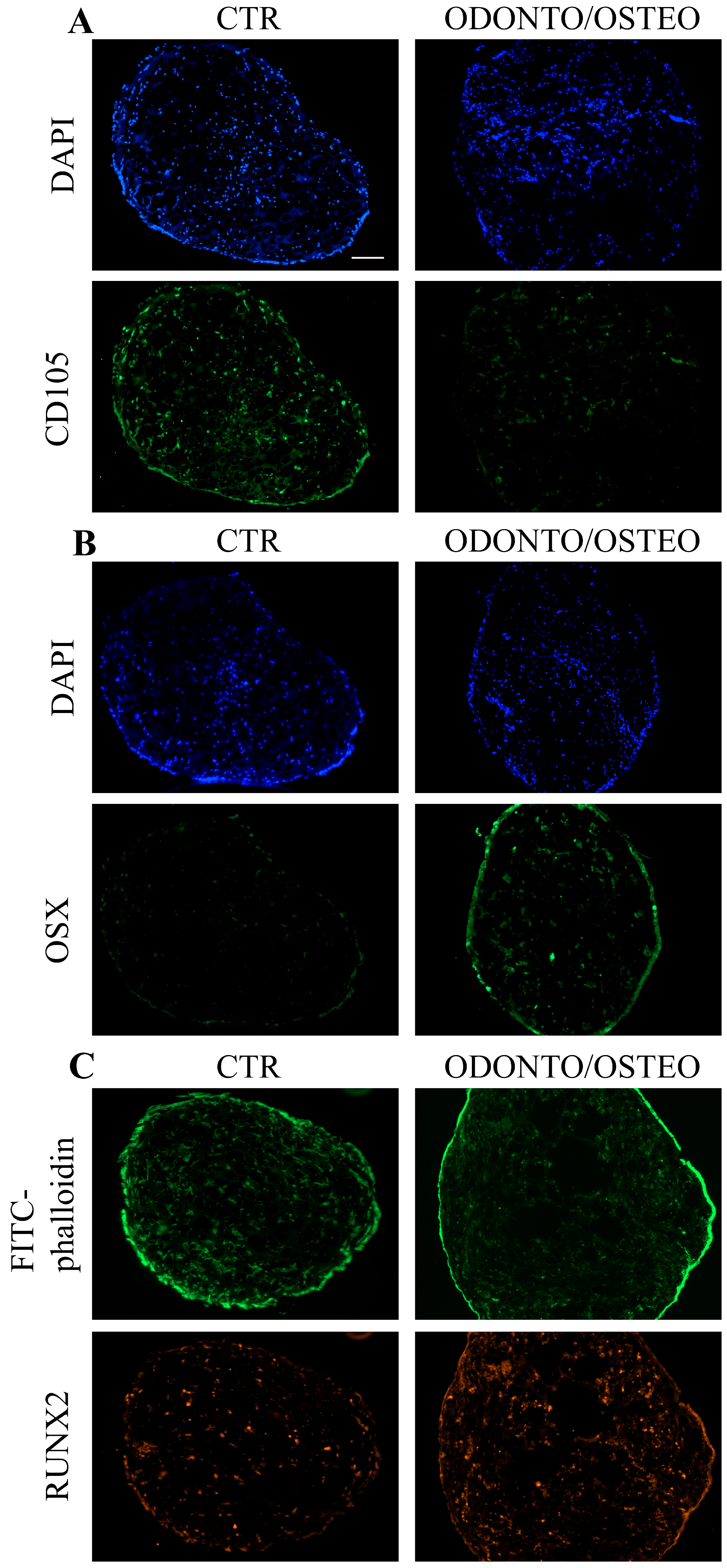
Disclaimer/Publisher’s Note: The statements, opinions and data contained in all publications are solely those of the individual author(s) and contributor(s) and not of MDPI and/or the editor(s). MDPI and/or the editor(s) disclaim responsibility for any injury to people or property resulting from any ideas, methods, instructions or products referred to in the content. |
© 2025 by the authors. Licensee MDPI, Basel, Switzerland. This article is an open access article distributed under the terms and conditions of the Creative Commons Attribution (CC BY) license (https://creativecommons.org/licenses/by/4.0/).
Share and Cite
Lancia, L.; Pulcini, F.; Mari, E.; Piccoli, L.; Biordi, L.A.; Mutti, L.; Festuccia, C.; Gravina, G.L.; Mattei, V.; Mauro, A.; et al. Dental Pulp Stem Cell-Derived Organoids: Advancing the Development of 3D Structures. Cells 2025, 14, 1603. https://doi.org/10.3390/cells14201603
Lancia L, Pulcini F, Mari E, Piccoli L, Biordi LA, Mutti L, Festuccia C, Gravina GL, Mattei V, Mauro A, et al. Dental Pulp Stem Cell-Derived Organoids: Advancing the Development of 3D Structures. Cells. 2025; 14(20):1603. https://doi.org/10.3390/cells14201603
Chicago/Turabian StyleLancia, Loreto, Fanny Pulcini, Emanuela Mari, Luca Piccoli, Leda Assunta Biordi, Luciano Mutti, Claudio Festuccia, Giovanni Luca Gravina, Vincenzo Mattei, Annunziata Mauro, and et al. 2025. "Dental Pulp Stem Cell-Derived Organoids: Advancing the Development of 3D Structures" Cells 14, no. 20: 1603. https://doi.org/10.3390/cells14201603
APA StyleLancia, L., Pulcini, F., Mari, E., Piccoli, L., Biordi, L. A., Mutti, L., Festuccia, C., Gravina, G. L., Mattei, V., Mauro, A., Notarstefano, V., & Monache, S. D. (2025). Dental Pulp Stem Cell-Derived Organoids: Advancing the Development of 3D Structures. Cells, 14(20), 1603. https://doi.org/10.3390/cells14201603










